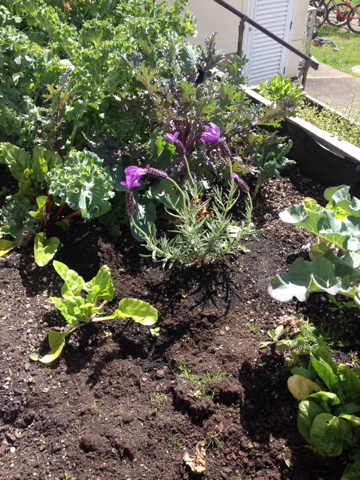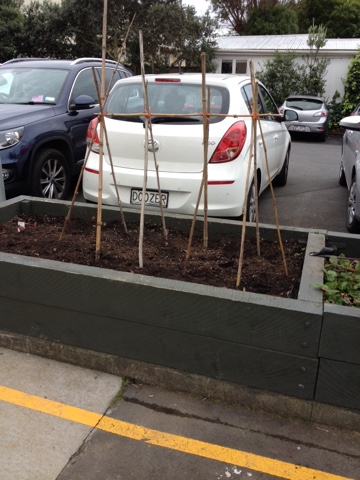Wowsers we have a cabbage!
Eeeewwwww cabbage! Children all over the world say.
Soggy cabbage is the worst way to eat cabbage!
We used our red cabbage to make coleslaw.
Red cabbage is not only much more exciting to look at, but it has more phytonutrients.
Phytonutrients are found in different coloured plants they are nutrients that give the plants their colour. Each colour provides different nutrients. When we eat the different coloured plants we get a variety of nutrients to use in our bodies.
Here is what we harvested to make our coleslaw.
Yes we are using super greens - kale.
What a perfect half a cabbage. No bugs inside!
We need to slice the cabbage finely. We could use the food processor, but we are practising knife skills.
We used the food processer to grate the carrot though!
We chopped up the herbs. We have mint and sage.
We took the tough stalks out of the kale and them sliced up the more tender leaves.
Mrs Mardell made a dressing from yogurt, orange juice, our herbs and a splash of apple cider vinegar. Apple cider vinegar helps to soften the cabbage and kale when we leave it to stand. The longer we leave the coleslaw to sit with its dressing on, the softer it becomes. This is why sometimes people don't put dressing on their coleslaw or salad until they are ready to eat it. They don't want soggy leaves, they want crisp leaves.
Then we tasted our coleslaw. Anything we didn't eat we put into the compost to recycle it back into compost for the next crop of vegetables to grow.
Year 4's learn to garden and cook experiencing a variety of fresh tastes from the garden.
Wednesday, November 16, 2016
Blogger app is down but we've been busy
At the end of 2016 the blogger app went down which made it impossible to blog!
Mrs Cowsill's class had so much fun in the gardens and got to harvest much of the other classes work.
Mrs Cowsill's class had so much fun in the gardens and got to harvest much of the other classes work.
Thursday, October 20, 2016
Feed the soil!
Today was all about caring for our plants. We can't take them for a walk but they still need feeding!
First of all we pulled out the weeds because weeds take away food from our vegetables.
Then Mrs Mardell sprinkled on blood and bone fertiliser. It's the most organic and SAFE fertiliser to use. We want to use safe products as we have small people around and these are vegetables we will eat. What we eat becomes us.
The blood and bone was stinky a few people said. We discussed where blood and bone came from.
We either raked the blood and bone into the soil or we covered it with ready prepared compost.
When it rains the nutrients will wash into the soil and our plants will suck them up through their roots.
What we planted:
A courgette plant. An alternative name for courgette is zucchini.
Six cherry tomato plants. Because Tomoto plants produce big tomato crops they need extra food. We dug the holes deeper than we needed we put tomato food in the bottom, covered the food with soil, then planted the tomato plants on top. These plants we need to keep well watered to have lots of juicy fat tomatoes!
Wednesday, October 12, 2016
Room 5 have begun their garden adventure
This week we are back into our garden to table program.
The gardens were a picture of abundance. They had grown crazily over the warm wet holiday period.
We all got to eat fresh peas straight from their pods.
At home remember to wait for the pods to become fatter if you are picking peas to eat. Leave the white flowers so they become the 'seeds' of the pea plant.
Pea plants are amazing because you can eat the shoots (soft sweet leaves and stems), the peas and the pods.
The broccoli plant in our garden has produced a broccoli floret, then because we were on holiday the plant let the floret bloom. So we learnt that the broccoli we eat is actually immature flower buds. Wow! We are leaving the flowers to attract insects and of course the bees!
We also noticed that the pakchoy and kale flowers look similar. And this is because all three plants are related.
They are from the brassica family.
Mrs Mardell did some research and found things she never knew. The brassica family all originated from a mustard plant. Each different brassica plant became unique when different parts of the plant became features. The plants became more and more different to each other when the same pollen of plants with the same feature was mixed together to make new seeds. The infographic explains this a lot better.
These are our common brassicas in NZ.Mrs Mardell told the class she had planted a brassica which was romanceso broccoli. It had amazing spirals rather than rounded bud forms and looked in between the colour of cauliflower and broccoli. It tasted delicious. Much better than shop bought cauliflower pr broccoli.
What else did we do?
We were so busy learning about gardening gloves, how to pull out weeds, how to plant, where the compost is made, what compost is, harvesting lettuces and beetroot that we forgot to take photos. Here is what we have.
Wednesday, August 31, 2016
Potting sunflowers
We have some amazing pots made from coconut husks that Greg bought in for us to use for seedlings.
We madly filled them with soil and planting sunflower seeds in weeks 5 and 6. Here they are ready for seeds in the shade and shelter of the old fig tree.
Here they are ready for seeds in the shade and shelter of the old fig tree.
 Here they are ready for seeds in the shade and shelter of the old fig tree.
Here they are ready for seeds in the shade and shelter of the old fig tree.We planted the seeds into them and put them into the sun.
Sophie and Lucy have been watering the sunflowers and other plants if it doesn't rain. So has Mr Koko. It takes lots of care for everything to grow. Thanks!
After two weeks the seeds have germinated and are beginning to sprout!
Room 6s garden glory
Over the weeks we've kept our gardens in top condition. This is our herb and seedling area
We've weeded. We've weeded a lot!
We've grown a bed of mustard so the phytonutrients given off by the roots kill harmful fungi that sprouted in the bed.
We've transplanted plants that are overcrowded, like our beans.
The strawberries had gone mad!
We've separated the strawberry plants that have grown from the runners while repotting the baby plants.
We started to raise seedlings that we will thin out and plant in our garden beds. These are lettuce sprouts.
We also planted pansies around the base of one of the butterfly plant gardens to add some spring colour!
Room 6 Cooking in the kitchen
Today we harvested the rainbow silverbeet also know as chard.
Sometimes we eat vegetables by themselves. Usually this is when we are least likely to like something. Often vegetables that have a taste we don't like can be put into other things to enhance the taste and nutritional quality of that food.
Mrs Mardell's first idea was to make tasty little treats for our lunchbox, but we just don't have time. You could easily make the recipe below at home for lunch with left over rice from dinner. They are full of protein to build body tissues, carbohydrates that are the 'petrol' for the body and goodness from the silverbeet.
http://onehandedcooks.com.au/recipe/gluten-free-rice-patties/
What we really made...
Silverbeet sautée with feta and currants
Heat olive oil in a fry pan till hot. (You can sautée 1-2 cloves of crushed garlic).
Add one or two bunches of silverbeet or a variety of silverbeet that has been finely cut.
Add a teaspoon of vegetable stock paste (there's plenty of liquid from the vegetables).
Cook stirring until it begins to soften then add 2 -4 Tablespoons dried currants and some sage from the garden of you have it.
Remove from heat and grumble feta over the top.
This is the remains...
Serve and eat.
This is actually one of Mrs Mardell's recipes she made up that she has with roast chicken or chorizo.
For more yummy nutritious recipes and lunch box ideas to make at home go to : onehandedcooks.com.au
Wednesday, August 3, 2016
Kale chips made by Room 6
Then we got into the good stuff.
Cooking kale chips!
We harvested some of the kale planted by Room 7.

Mrs Mardell had brought along a third type of kale.
Use the chart below to identify what kale we used to make our kale chips.
We washed the kale and dried it.
We washed the kale and dried it.
We gently peeled the leaf away from the tough stalk. We kept the leaves and composted the stalks. Breaking up the woody stalks makes it easier for them to break down in the compost heap.
YUM YUM YUM!
Click here for the Kale chip recipe!
Click here for the Kale chip recipe!
Wednesday, July 27, 2016
Room 6 start garden to table in term 3
We started garden to table but then it started raining REALLY hard! So we used this time to plan what we wanted to learn by making a padlet to collate our ideas.
We managed to sneak out between the rain and tour the gardens and see all the different systems that support them such as the compost and the worm farm.
Interesting things we learnt even though it was raining...
Some of our fruit trees are grafted. We spoke about what this meant and why we would want to graft plants together. We learnt that often a fruit tree would have its young branches grafted to form a new plant with all the qualities desired. This little diagram explains grafted a flowering plant.
Most berries except strawberries need the cold to grow.
Fruit and vegetables are ripe ready for eating during different seasons.
Many of the fruit trees didn't have leaves and looked like this.
Plants grow better when it is warm.
Room 6 planning task :
Cut and paste this link to add what you would like to learn with your name on the comment :///cmardell/x70euuhiv1ve
The odd and even groups homework task is to think of a name for their groups and we will vote next week.
Wednesday, July 6, 2016
Room 7s last garden to table week of term 2
This week is sadly the last week for room 7 to use their gardening skills and we were busy for 2 whole hours!
We were experts planting the last seedlings - Mrs Mardell was very impressed how knowledgeable we were.
We weeded the gardens and were VERY surprised at how even more mint had sprouted.
We harvested the kumara following the tuber roots.
We transplanted swan plants to make a second swan plant garden to attract monarch butterflies.
We saw that the garlic and peas we had planted were sending out shoots.
Mrs Mardell was impressed that we led making compost, planting seedlings and weeding? She overheard a couple of room 7 children say "we love weeding".
Well done Room 7, it's been so much fun and I hope you help out in the garden at home to grow some food!
Subscribe to:
Comments (Atom)



















































